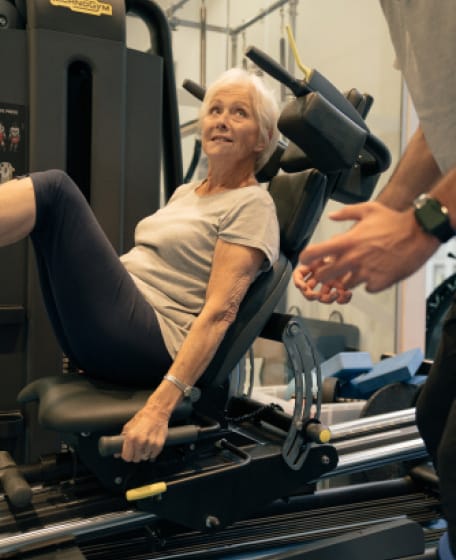Act on Axial SpA: Early Diagnosis and Management Tips

Pure Sports Medicine
- 5 July, 2021
- Sport, Exercise & Musculoskeletal Medicine
- Podiatry
- 4 min read
Back pain. We’ve all heard of it. Most of us have probably experienced an episode of it at some point in our lives. It is common, frequently not caused by any structural damage and often resolves relatively quickly (within 3 months).

However, there is a category of low back pain which requires a more detailed examination and investigation in order to improve outcomes and prognosis – inflammatory back pain.
It is important to differentiate between inflammatory back pain and the type of back pain described above, as the management can be quite different.
Inflammatory back pain can be one of the signs of a wider picture of symptoms caused by Axial Spondyloarthritis. (Axial Spondy-lo-arthritis). A bit of a mouthful, and something a lot of people have never heard of.
Axial Spondyloarthritis
Axial spondyloarthritis (Axial SpA) is a life-long inflammatory condition that primarily affects the spine and sacroiliac joints. Symptoms can flare and settle over many years and flares are not always related to an incident.
The condition can present differently to other forms of low back pain and may require different diagnostic approaches to confirm the disease. The diagnosis can be challenging, and due to this, there is often a delay in correctly diagnosing Axial SpA.
Sadly, the current time to diagnosis in the UK averages 8.5 years from symptom onset.
Axial SpA is more common than people realise, affecting 1 in 200 adults in the UK, which is more than the number of people with multiple sclerosis and Parkinson’s disease combined. The average age of onset is 24 years.
This means that there are potentially thousands of people at any one time who are living with debilitating and painful symptoms, but with no agreed clinical explanation or treatment path.
Almost 40% of individuals with Axial SpA do not contact a healthcare practitioner within a year of symptom onset.
Impact of delay
Axial SpA typically starts in the second or third decade of a person’s life, often derailing hopes and dreams at a critical time for attempting to establish careers and relationships. A delayed diagnosis during these formative years can therefore be extremely disruptive. Some people report not feeling listened to or believed about their symptoms, while others feel helpless and withdraw from care completely, leading to further diagnostic delay.
People with delayed diagnosis may also suffer from a less favourable response to treatment and worse outcomes in diseased activity, fatigue, function, spinal mobility and damage to the spine. These individuals also experience difficulty sleeping and have a higher prevalence of mental health disorders.
Diagnostic delay was consistently related to a higher risk of work disability or unemployment and associated with job loss. Specifically, one study demonstrated that unemployment rose from 20% among people diagnosed with axial SpA within four years, to more than 40% among those with a delay of over 10 years.
Recognition
Evidence emphasises the importance of recognising the condition early in order to access treatment quicker and prevent the decline in daily function, work and mental health.
We know that targeted awareness building and education can positively impact the time it takes to get an accurate diagnosis.
Evidence suggests that we need to promote and provide sustained education and awareness among the public and healthcare professionals to ensure that Axial SpA is at the forefront of clinical reasoning.
Greater public awareness of Axial SpA and its wide range of symptoms will also help to tackle this unacceptable delay of receiving a diagnosis.
SPINE acronym and symptom checker
Differentiating between a person’s symptoms can be difficult, and can make it very hard for someone to know if they need to see a healthcare professional about their back pain.
Here are a couple of handy tools that have recently come in to circulation.
The SPINE acronym sets out the key symptoms of inflammatory back pain, to help differentiate it from different causes of back pain:
S – Symptoms starting slowly
P – Pain in the lower back
I – Improves with movement
N – Night time waking
E – Early onset (under 40)
Another tool is a symptom checker. This 8-point questionnaire, also available online, can be used to check if current symptoms are representative of inflammatory back pain, and if the person needs to consult with a doctor.
A score of 5 or more denotes that further health professional advice should be sought.
- Did your back pain start before the age of 40? – Yes
- Did your back pain develop gradually? – Yes
- Has your back pain lasted more than 3 months? – Yes
- Do you experience stiffness in your back in the morning for at least 30 minutes? – Yes
- Does your back pain improve when you move around? – Yes
- Does your back pain improve when you rest? – No
- Do you have pain in your buttocks, which moves from one buttock to the other? – Yes
- Do you wake in the second half of the night because of your back pain? – Yes
Online version: https://www.actonaxialspa.com/symptoms-checker/
These tools are only a start. If you, or someone you know, are experiencing some of the symptoms above, please see our Rheumatology service page, and contact us for more information or to book an appointment.

Advice
Over the last 20+ years our experts have helped more than 100,000 patients, but we don’t stop there. We also like to share our knowledge and insight to help people lead healthier lives, and here you will find our extensive library of advice on a variety of topics to help you do the same.
OUR ADVICE HUBS See all Advice Hubs

